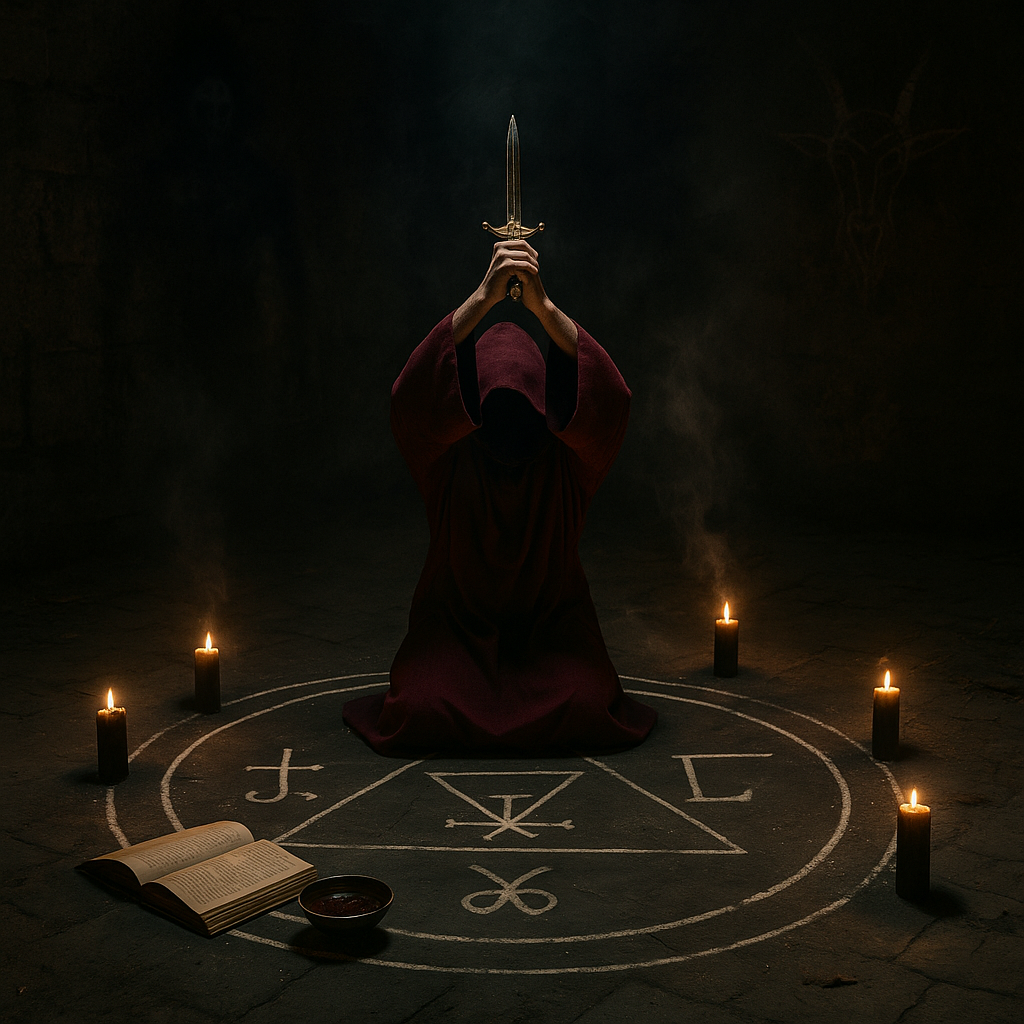Luciferian Binding Ritual

For those unfamiliar with the term, a Luciferian Binding Ritual is a type of occult ceremony meant to spiritually bind an entity—often viewed as a demon, spirit, or force—to the practitioner’s will, a specific location, or a physical object. The purpose may be protection, gaining influence, or preventing harm. Contrary to sensationalized horror movie portrayals, many who perform these rituals believe they are engaging in a form of energetic contract with non-human intelligences.
While some seek spiritual insight or personal transformation, others hope to gain short-term advantage in material or psychological challenges. Motivations vary widely—some feel powerless in life and seek to reclaim agency through ritual. Others are drawn by curiosity, the allure of forbidden knowledge, or a desire to transcend traditional religious systems. For certain practitioners, it’s not about ‘fighting darkness’ or ‘joining darkness,’ but about mastering it—tapping into forces most fear or reject and bending them toward a personal goal.
Still, there are individuals who deliberately pursue these rituals as a way of aligning with malevolent forces for short-term power, revenge, or psychic dominance over others. The line between protection and aggression can blur in these systems, and what one practitioner sees as a defense, another may view as spiritual warfare. Additionally, some practitioners describe these rituals not as acts of control but as cooperative pacts—agreements formed with spiritual intelligences who are invited, not coerced. In this perspective, binding is symbolic of mutual alignment, where the practitioner and entity enter into an energetic accord based on purpose, will, or shared intention.
Though exact numbers are difficult to determine, the practice exists quietly within Luciferian, Thelemic, and demonolatory circles around the world. These rituals are rarely public and often passed privately through books, grimoires, or online occult forums. For the average person, it may seem bizarre—but for practitioners, it’s seen as a form of ancient knowledge tapping into unseen forces that mainstream systems ignore or suppress. Some also believe that such rituals carry a karmic or energetic cost—especially when used for manipulation or harm—suggesting that the power gained comes with a price.
In occult and UFO circles alike, there is growing speculation that reports of shadow figures, sleep paralysis entities, and unexplained energetic phenomena might stem from the unintended consequences of binding rituals performed by others, knowingly or not. Supporting this view, Father Malachi Martin, a former Jesuit priest and exorcist, warned of a growing spiritual crisis he called ‘The Quickening’—a global acceleration of demonic activity, moral decay, and social breakdown. Martin spoke of the ‘perfectly possessed,’ individuals who have fully integrated with dark spiritual forces, often willingly. His insights lend weight to concerns that binding rituals may open the practitioner to prolonged or irreversible spiritual influence, intentionally or otherwise.
The figure of Lucifer (Latin for “light-bringer”) first appears in Isaiah 14:12, referring to the morning star—planet Venus. Over centuries, Christian theology reinterpreted this poetic image as a reference to Satan. Writers like Dante Alighieri, author of The Divine Comedy, and John Milton, author of Paradise Lost, solidified this idea in Western imagination, presenting Lucifer as a defiant fallen angel. By the 13th century, texts such as Gesta Treverorum and Pope Gregory IX’s Vox in Rama began associating heretical cults with Lucifer, though these may have been fabricated for political or ecclesiastical control. In the Enlightenment and Romantic periods, radicals reclaimed Lucifer as a symbol of rebellion, autonomy, and wisdom—exemplified by publications like Lucifer the Lightbearer and Blavatsky’s theosophical journal Lucifer.
Luciferianism spans a spectrum of beliefs. Theistic Luciferians revere Lucifer as a spiritual being, using rituals like invocations and spirit communication. Atheistic Luciferians and LaVeyan Satanists treat Lucifer symbolically, focusing on inner empowerment through theatrical or psychodramatic rituals. Theistic Satanists and demonolators often treat Lucifer as an ally or mentor in ceremonial magic, placing him in elemental rituals such as Air in the East. Ceremonial magicians, particularly in Goetic traditions, use grimoires like the Grimorium Verum or Lemegeton to bind or summon spirits like Lucifer using sigils and sacred circles. Esoteric Orders such as Fraternitas Saturni view Lucifer as a cosmic Light-Bringer, combining astrology and ritual to seek illumination through cosmic law.
A Luciferian Binding Ritual is likely a magical practice where practitioners bind spirits, demons, or entities to themselves, a location, or an item, often for purposes like protection, empowerment, or restricting others’ actions. These rituals are rooted in Luciferianism, a belief system that venerates Lucifer as a liberator or light-bringer, not necessarily the devil. A useful contrast can be found in the Abramelin Operation, a separate ceremonial tradition aimed at uniting the practitioner with their Holy Guardian Angel. While the Abramelin path seeks divine communion and spiritual enlightenment through purification and discipline, it also culminates in the subjugation of demonic entities—mirroring the power dynamic found in some binding rituals. This comparison reveals a broader spectrum of Western occultism: one that ranges from angelic alignment to pacts with infernal intelligences, with both paths requiring contact with powerful non-human entities. The practices can involve invocations, visualizations, and specific materials like blood, bones, or ritual tools.
In practical magic, “binding” refers to limiting a person’s or spirit’s power. Binding rituals might involve symbolic cords, ritual circles, candles, or wax effigies. Some grimoires instruct how to invoke and bind Lucifer or his associated spirits. Sources such as the Luciferian Apotheca provide binding spell kits designed to restrict another’s actions or to bind spirits or demons to oneself, a location, or an item. Another example, found in the text “The Binding of Shadows,” describes a ritual involving graveyard soil, bones, and blood to summon protective elemental spirits known as shades. These spirits are empowered by the practitioner’s life force and instructed to guard the practitioner during dreamwork or magical rites. The ritual includes mechanisms for protection and the banishment of unwanted energies.
The intersection of ritual, energetic manipulation, and intention mirrors theories in dimensional contact literature, suggesting that such rituals may alter perception and create gateways.
Luciferian imagery blends astrological, alchemical, and occult symbolism. Morning Star or Venus signifies dawn, enlightenment, and rebellion. The Sigil of Lucifer, a stylized triangle and cross, represents light and knowledge. The Leviathan Cross symbolizes alchemical sulfur and infinity and was later adopted as a Satanic emblem of the boundless soul. Baphomet symbolizes duality—male and female, spirit and matter—with a torch for enlightenment and a caduceus representing balance. The inverted pentagram represents defiance and the reversal of spiritual hierarchy. The magic circle is seen as a space of power and unification, not imprisonment. The ouroboros—a serpent eating its own tail—appears in some Luciferian systems as a symbol of eternity, cyclical transformation, and the continuous rebirth of the practitioner’s power. The triangle within a circle is another geometric motif sometimes used to symbolize the containment and focusing of intention, a portal between dimensions. The Eye of Lucifer or flaming eye symbol can represent awakened inner sight or divine rebellion, echoing both Promethean fire and the inner light sought through ritual. In advanced traditions, planetary seals—especially those of Venus (Lucifer) and Saturn (Fraternitas Saturni)—are used to map celestial alignments believed to influence the efficacy of ritual. Binding and banishing rituals may share similar elements of visualizations, breath control, and the projection of spiritual energy, pointing to overlapping functions in protection and empowerment. From an interdimensional lens, these actions might also correspond to disruptions or stabilizations in unseen energetic fields, inviting speculation about the true nature of the entities involved.
Grimoires like Grimorium Verum imply steps such as consecrating a space, using sigils, invoking Lucifer, and speaking commands. Blogs and modern authors suggest using three candles in a triangle, reciting infernal names, declaring personal intent, and performing symbolic actions like binding with cord or sealing with wax. Rituals often include invoking entities such as Lucifer, Azazel, Lilith, Samael, Mephistopheles, and Abaddon, with goals including protection, control, or spiritual transformation. Most rituals emphasize willpower and clarity of purpose over dogma. Some warn against misuse, stating that binding should be used sparingly and ethically. The diversity of practice, from solitary rites involving sigils and visualizations to organizational rites in Luciferian witchcraft, reveals an evolving and contested field of occult activity.
Some Luciferians, especially those interested in transdimensional phenomena, believe that non-human intelligences—commonly described in UFO literature—are part of a broader spiritual ecosystem. These entities are not always extraterrestrial in the traditional sense but may be considered ultraterrestrial, interdimensional, or archetypal. Channeling is accepted by some Luciferians as a valid technique, not to surrender to external authority, but to access hidden knowledge. Practitioners may claim to receive messages from beings like Lucifer, ancient watchers, or unknowable forms beyond human perception. This overlaps with beliefs about astral projection and dreamwalking into non-ordinary realms.
For researchers of anomalous phenomena, the overlap between magical ritual, energy work, and non-human interaction presents a provocative frontier. Whether metaphorical or literal, Lucifer remains a potent symbol of light, rebellion, and volatile influence.

